Comparison of 40-foot deck saloon yachts Part II: How the candidates perform when sailing
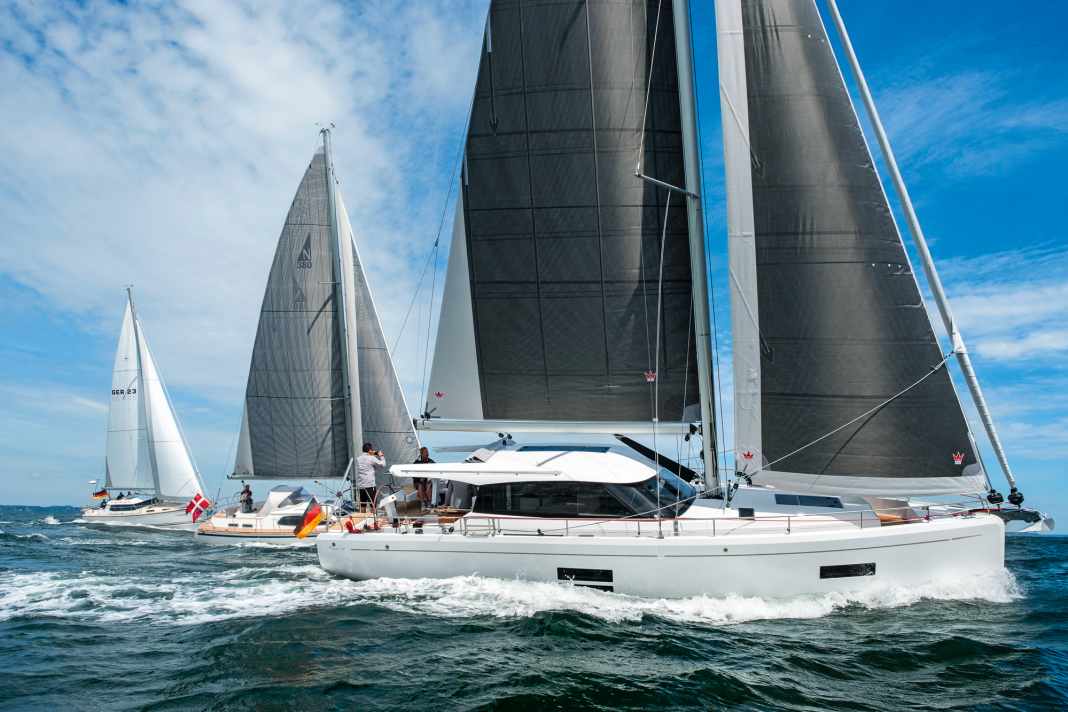





The theme of the deck salon can be interpreted in very different ways, according to the summary from the first part of the 40-foot group test. The comparison clearly showed how differently the manufacturers approach and implement the same topic.
The candidates
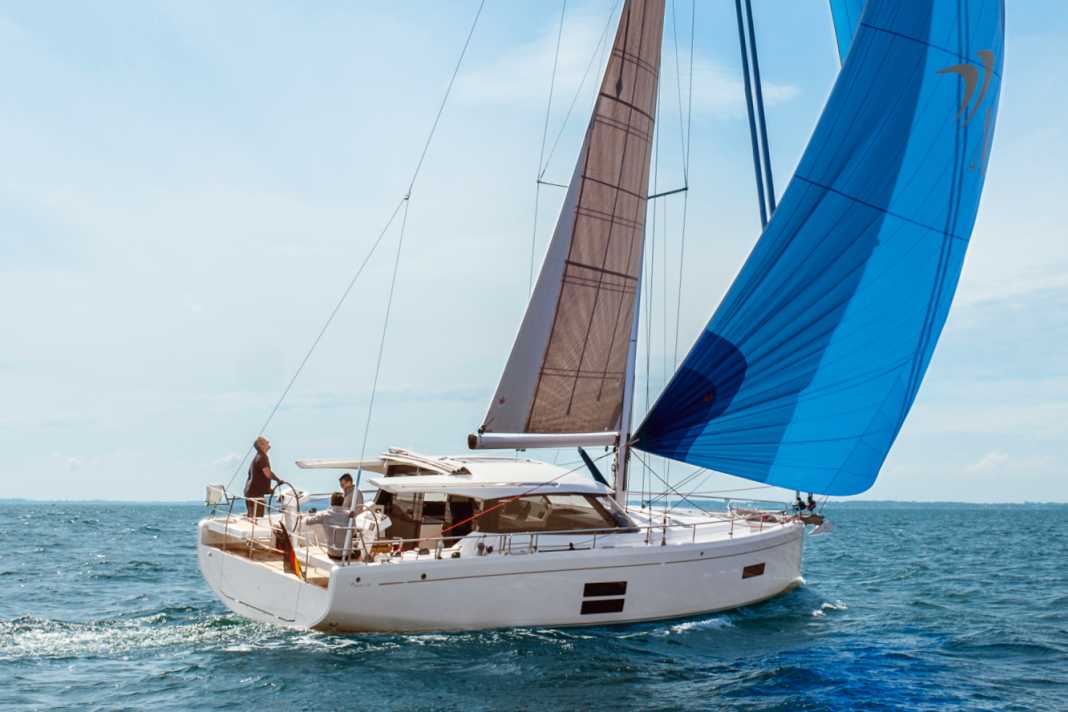





Moody Boats takes on the competition with the DS 41. The boat from Hanseyachts AG in Greifswald is characterised by the consistent combination of deck saloon and cockpit on one continuous level, similar to a catamaran. Nordship Yachts from Denmark is sending the somewhat smaller and older 380 DS into the race. It combines the deck saloon with a centre cockpit and master cabin aft, which is unique in the twelve-metre hull length class. The group is completed by the Sirius 40 DS from Lake Plön. Above all, it stands out from the competition with its enormous variety of expansion options.
For the second part of the group test, the deck saloon yachts have to prove what they can do under sail, how they are equipped for this and how they can be operated. The construction is also scrutinised.
All parts of the comparison test:
Test with surprises
Due to a technical defect on the machine, the Moody DS 41 arrives late for the comparison test in Neustadt. However, perfect test conditions on the final day with winds between 12 and 15 knots quickly made up for the delay in the schedule. On a longer course, all test yachts are initially set with either a gennaker (Moody) or a furling Code Zero. On a course of around 120 degrees to the wind and more, none of the test boats are able to pull away decisively; the group remains more or less close together.
Not so on the cross. Hard upwind, the Nordship 380 DS shows more potential than the competition and pulls away. This is surprising because, with a hull length of 11.60 metres, the Danish yacht is around 40 centimetres smaller than the competitor yachts from Sirius and Moody and, with her comparatively conservative hull lines, also has a significantly shorter waterline. The Nordship 380 DS not only sails fast, but can also run a very good height upwind and accelerates better in comparison. With a total weight of 9.0 tonnes, she is around two tonnes lighter than her competitor. Surprisingly, the dominance of the Nordship, which is only equipped with a self-tacking jib, is maintained even when the overlapping genoas, which have already been struck, are rolled out on the Moody and Sirius as a test, with the measure proving particularly effective on the Moody.
More deck saloon yachts
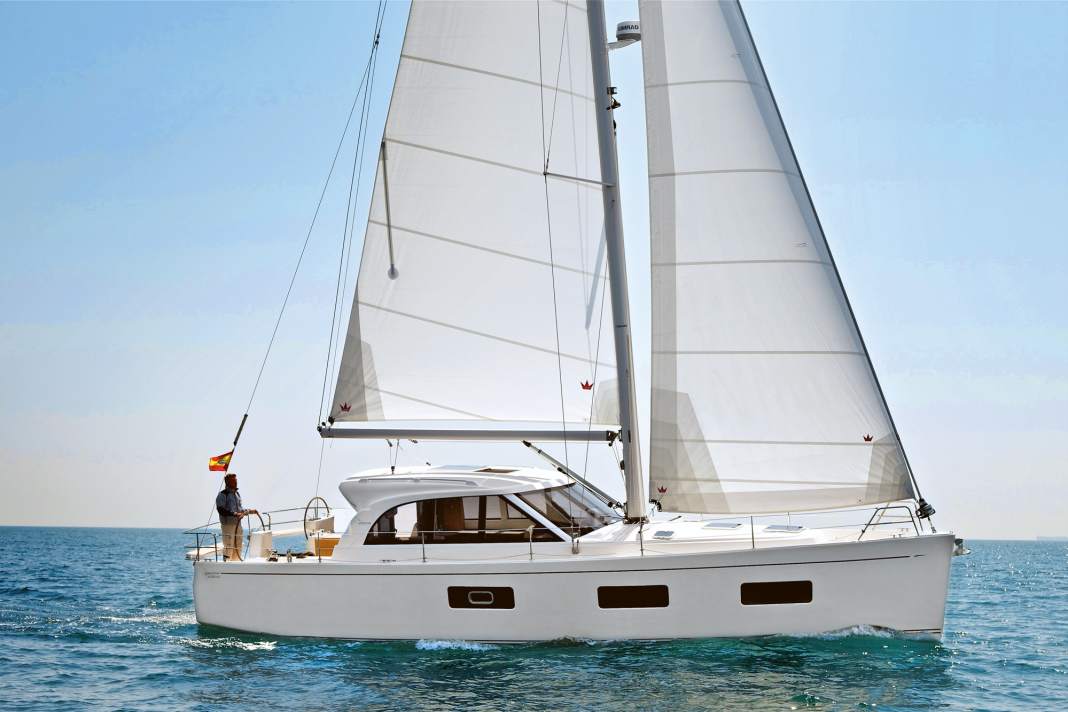




The Sirius 40 DS suffers somewhat in the wind from its simple sails with standard Dacron material and a very flat mainsail - it falls behind in direct comparison. Both the Moody and the Nordship benefit from an equipment upgrade with laminate sails and a vertically battened mainsail. All three yachts are equipped with a furling mast from Seldén. On the Moody, this is already part of the standard scope of delivery. Due to the fixed bimini with convertible top and the associated inaccessibility of the main boom, a conventional rig would make little sense for her. All three comparison models are also equipped with a self-tacking jib from the shipyard. Larger, overlapping headsails as well as room wind cloths such as gennakers and code zero are of course available from all manufacturers for a corresponding surcharge.
Low at the bottom or high at the top
On the Moody, the sideways recessed running deck and the aft steering cockpit are at the same level, which enables a smooth passage from the cockpit to the foredeck. In a kind of channel between the cabin superstructure and the bulwark, which is around 30 centimetres high, you move with a high degree of safety, even when heeling. And the winches on the aft cockpit coaming are easy to reach from the cockpit as well as from a lateral position and can be operated efficiently by the crew and helmsman alike. All sheets, halyards and trim lines are led back into the cockpit aft on both sides. In this respect, the Moody offers advantages in terms of handling.
The cockpit on the Nordship is clearly divided into two sections. The guests sit comfortably and well protected in the high centre cockpit at the front, but have little to do when underway. On the other hand, the helmsman, who is separated aft behind the bridge deck in a deep recess at the wheel, has to work all the harder. All the functions for trimming the sails are within his immediate reach. Equipped with a self-tacking jib and furling main, the Nordship scores highly in terms of single-handed manoeuvrability. However, the helmsman is restricted in his freedom of movement and has to climb awkwardly to get from his position to the running deck or forward to the centre cockpit.
The cockpit of the Sirius is rather narrow, but is at a very low level and offers good protection from wind and weather thanks to the huge deckhouse at the front and the high coaming at the sides. With a length of 2.40 metres, the cockpit thwarts of the Sirius are the longest in the comparison and can therefore also be used as sun loungers, even if the seats are relatively narrow. As an option, the boat from Plöner See is available with a tarpaulin bracket above the cockpit, to which a sprayhood, a fabric bimini or a complete cockpit tent can be attached. All sheets, halyards and trim lines on the Sirius are led over the cabin roof on one side. On the test boat, no fewer than eight lines run there, all of which are operated with just one electric winch. This requires discipline in the procedures and more time when setting and trimming the sails.
Three boats, three mindsets
In the first part as well as in the individual test, we recognised the unusual variance for the individual design of the Sirius 40 DS interior. This variety also extends to the exterior, for example in the choice of keels. The permanently attached L-shaped fins and ballast bomb are available in no less than three draught variants of 2.30, 2.00 or 1.75 metres. The ship can also be fitted with chine keels for dry running in tidal waters or with a swivelling keel for a variable draught. All keel variants can also be combined with either one or two rudder blades. The Moody and Nordship ships, on the other hand, remain with fixed keels in two draught variants and a rudder blade with no alternatives.
In terms of steering, the Nordship is the best of the three yachts. Well-trimmed, the Danish yacht can be held on the edge of the wind with a lot of feeling, she reacts excellently and lively to even the smallest rudder movements. Steering her is therefore more fun than on the boats of the competition. The Jefa system on the Nordship works via a continuous cable pull directly on the quadrants. The situation is different on Moody and Sirius, where semi-cardanic steering systems with chain hoists, reversing gears and push rods are installed. These systems (also from Jefa) are technically very reliable and are considered virtually indestructible, but generally do not offer the same sensitive steering feel as the more delicate and smooth-running cable pulls. Moody Boats also uses the double wheels to make the steering system fully redundant with two independently functioning mechanisms, meaning double safety in the event of a defect.
On the Moody and Sirius ships, the view forwards from the helm station is restricted due to their large, bulky deckhouses - the helmsmen have to stand permanently in order to have a clear view forwards. Sitting or in a crouched position, it is possible to peer through the all-round glazed cabin superstructures, but only to a limited extent. On the Nordship, on the other hand, the helmsman stands or sits in the centre cockpit high above the water, dry and with a perfect view in all directions.
Storage space in abundance
The stern of the Moody is over four metres wide and therefore has by far the largest projection aft. Accordingly, the bathing hatch can be larger than on the Sirius, whose hull lines tend to converge aft. The bathing platforms of both yachts are easily accessible and equipped with solid and well-anchored bathing ladders. For the centre cockpit concept of the Nordship with the large owner's cabin in the stern, however, a hatch is not reasonably feasible. A platform integrated into the stern makes bathing easier, and the fairly solid ladder can be folded out for this purpose. However, if you want to get in or out of the water, there is still no getting round a small climb at the stern.
In terms of storage space on deck, the Moody is far ahead in comparison. Due to the recessed cockpit, it is no longer possible to fit out the interior behind the deckhouse. This allows the shipyard to make the large spaces in the stern accessible as huge forecastle boxes, which together offer around 3.5 cubic metres of storage space. In addition, the boat from Greifswald has a proper sailing load in the bow between the anchor locker and the forward cabin as well as a wet lazarette in the stern.
Key figures and measured values






Although the aft locker on the Sirius is also deep and spacious, it only offers around half the storage volume of the Moody. However, the shipyard can also build its 40 DS in versions without an aft cabin, but also with additional stowage space. On the Nordship with centre cockpit and owner's cabin in the aft section, there is less unbuilt volume available for use as stowage space, but some of this can also be accessed from the inside.
The construction methods are standardised. All three shipyards manufacture the hulls and decks of their boats as GRP sandwich constructions with a core of balsa wood and laminate them by hand using vinyl ester resins for the outer layers and polyester on the inside. Below the waterline, the hulls are fully laminated, i.e. without a core. The bulkheads are laminated on all three boats.
A lot of money for a lot of ship
With a base price of 850,850 euros, the Sirius 40 DS is the most expensive boat in the comparison. The exceptionally good workmanship inside and out, the exquisite fittings and the versatility of the boat go some way to explaining Sirius' upmarket pricing policy compared to the competition. Nevertheless, it is ultimately more than 225,000 euros more expensive than the Moody DS 41, which, with a base price of 624,630 euros, narrows the price range in comparison. The Nordship 380 DS is available from the shipyard for 635,740 euros.
The conclusion after the comprehensive comparison test of deck saloon yachts in two parts sees none of the three exclusive deck saloon yachts as the clear winner. The orientations of all three boats have various advantages, but also disadvantages. Nevertheless, the direct comparison is extremely exciting, precisely because the concepts and designs are so different.
YACHT rating of the Moody DS 41
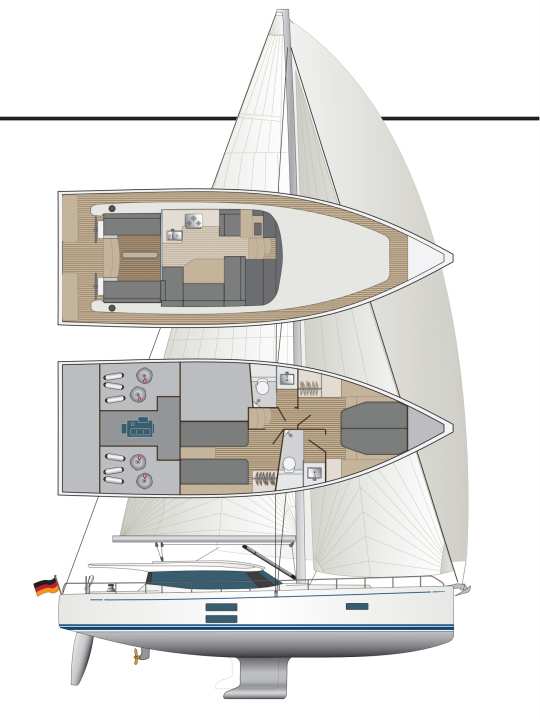
The combination of cockpit and deck saloon on one level makes sense and has no disadvantages for handling under sail. The Moody is already well equipped from the shipyard and is also cleanly built
Sailing performance and trim
- + Solid performance in windy conditions
- + Functioning cockpit layout
- - Restricted view to the front
- - Slightly sluggish with self-tacking jib
Equipment and technology
- + Control with redundancy
- + Rolling mast as standard
- + Extremely many storage spaces on deck
- + Largest bathing platform in comparison
- - No Traveller possible
YACHT review of the Nordship 380 DS
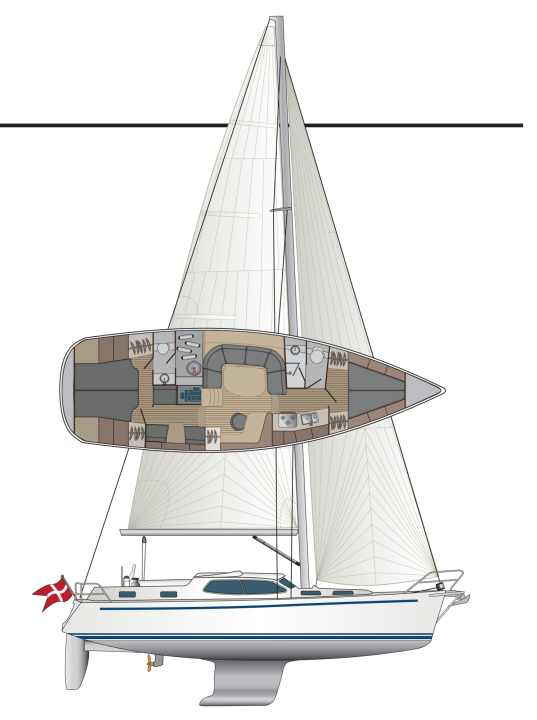
Despite her rather conservative hull lines and the less sporty centre cockpit, the Nordship ultimately comes out on top under sail. The price/performance ratio is very attractive
Sailing performance and trim
- + Sails fast and high
- + Sensitive steering feel
- + Good one-handed suitability
- - Cumbersome control position
Equipment and technology
- + High-quality deck fittings
- + Easily accessible control mechanism
- + Mainsheet guide with traveller
- - No bathing platform possible
- - Comparatively little storage space
YACHT review of the Sirius 40 DS
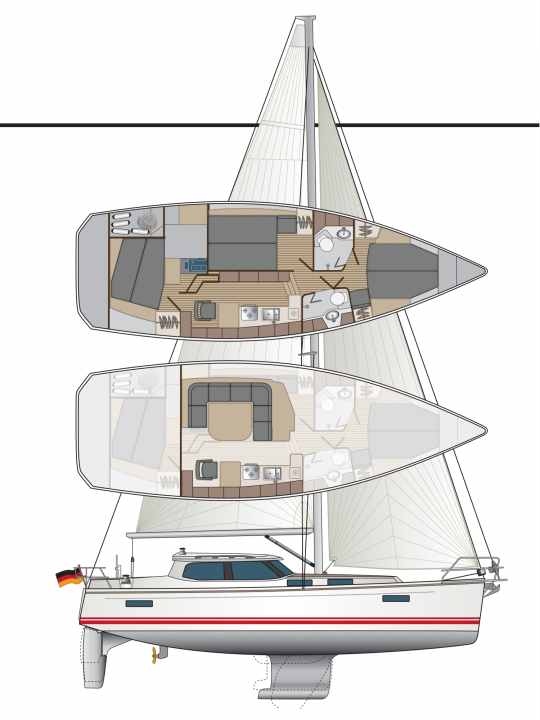
The Sirius sets the standards in the group in terms of quality and standard of equipment. However, it is also significantly more expensive than the competition. The boat is quite heavy and feels a little sluggish in light winds
Sailing performance and trim
- + Good handling during manoeuvres
- + Plenty of space for the crew in the cockpit
- - Less potential in comparison
- - Restricted view to the front
Equipment and technology
- + Many keel variants
- + Longest cockpit dents in comparison
- + Exquisite basic equipment
- + Solid bathing platform
- + Large, easily accessible anchor locker
Comparison of deck saloon yachts in the video
This article first appeared in YACHT 19/2020 and has been updated for this online version.

